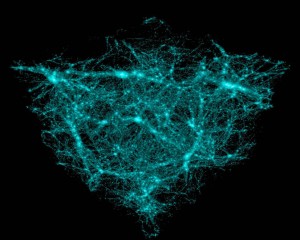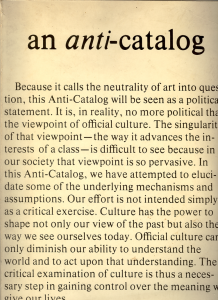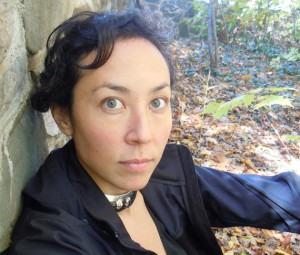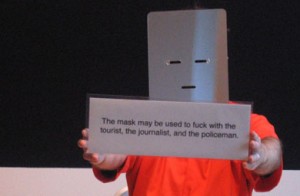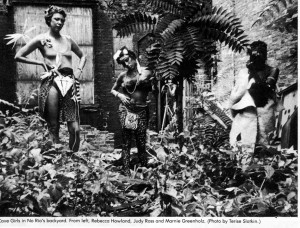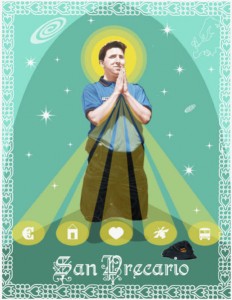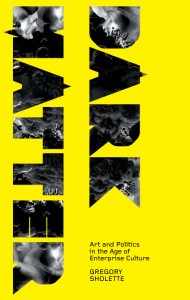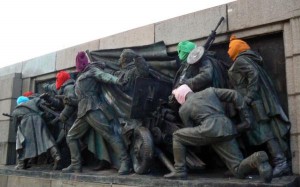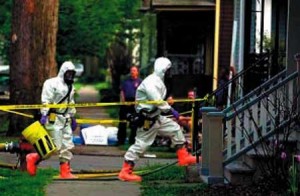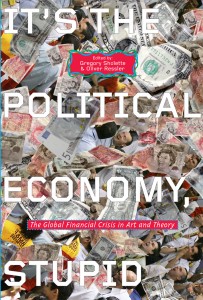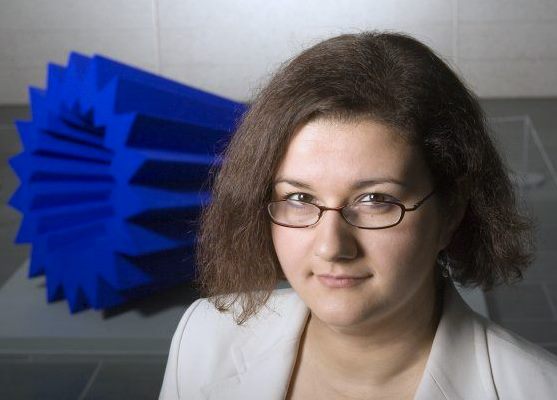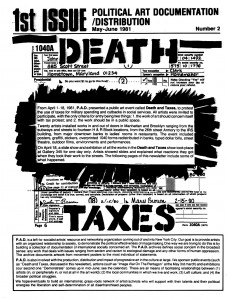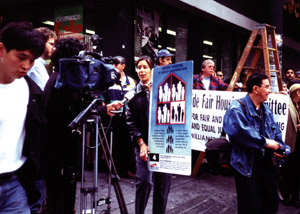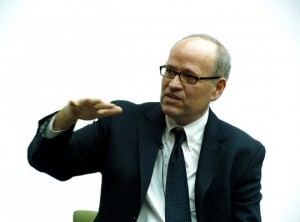Download a pdf of syllabus here: Dark Matter Syllabus GC Spring 2013
ART 86040 – Seminar: Selected Topics in Contemporary Art
[20170]; cross-listed ASCP8 1500
Dark Matter: Socially Engaged Art and the Political Economy of Contemporary Culture Professor Gregory Sholette
Mon. 2:00-4:00
CUNY Graduate Center Rm. 3421
365 Fifth Avenue
gsholette@gmail.com
Art is big business: a few artists command huge sums of money, the vast majority are ignored; yet these marginalized artists remain essential to the mainstream cultural economy serving as its missing creative mass. At the same time, a rising sense of oppositional agency is developing within these invisible folds of cultural productivity. Selectively surveying structures of visibility and invisibility, resentment and resistance, this seminar will focus on the present and past state of the archive made up of alternative hybrid cooperative networks, systems of artistic gift exchange, tactical media , and community based public art. Participants will research such artists’ groups as Pussy Riot, Viona, W.A.G.E., W.H.W., The Yes Men, Temporary Services, Group Material, PAD/D, while reading historical and theoretical texts by Adorno, Brecht, Bishop, Bourdieu, Debord, Lippard, Mouff, Enwezor, Steyerl, Kester, and others. Auditors by permission.
__________________________________________________________________________
Requirements
Students will choose a research topic and give oral presentations with class discussion and use this feedback to fine-tune a fifteen-page research paper due at the end of the semester.
Preparation and Attendance
The readings and viewings listed below are to be done prior to class. Unless otherwise indicated they will be available online at I-site. You are asked to prepare a list of 2-3 discussion questions based on the reading/viewing to bring to class each week (for example: what is the author’s central argument and is it well defended in the text? What are the operative terms and definitions employed? How would the same facts or arguments sustain a different thesis or answer? What would Theodor Adorno or Walter Benjamin or another thinker we will study think of this argument? Does the essay appear have a direct relationship to your own art or research practice and how?). These 3 questions must be turned in at the beginning of class.
Research
This is a research seminar, and a list of potential research topics is included below, however, you can also propose a topic of your own that is not on this list. A statement indicating your choice of research topic and a preliminary bibliography is due by April 1st. Please consult with me before about your choice. Be prepared to engage in original research including interviews and archival investigation because little published material exists on these topics.
Presentations
The last three weeks of class will be devoted to student presentations. These are to be based on your research, but not a straightforward reading of your papers due at the end of the course. The aim of the presentation is to teach your classmates (and professor) about the artist, group, or phenomenon you have been researching. You will be responsible for assigning a reading (one article each, to be distributed the week before your presentation), and giving a 12-minute lecture on your topic (with images) leaving 10 minutes for discussion.
Presentation topics will be chosen in consultation with the instructor.
Presentation Format: Five Components
1. Start with a premise or thesis about your topic or artist.
2. Provide background details, dates, and relevant information. (* who-what-why-where-when.)
3. Elaborate on your thesis, but don’t give your opinion.
4. Whenever possible quote directly from relevant texts, documents, and/or the artist or group.
5. Conclude by raising a series of questions your research has raised.
Books recommended but not required
Art Workers: Radical Practice in the Vietnam War Era, Julia Bryan-Wilson, U. California, 2009.
Alternative Art New York: 1965–1985, Julie Ault, ed., U. Minnesota, 2002.
Show and Tell: A Chronicle of Group Material, Ault, Ashford, Locks, eds., Four Corners Books, 2010.
Collectivism after Modernism: The Art of Social Imagination after 1945, Stimson & Sholette, Minn., 2007.
Dark Matter: Art and Politics in the Age of Enterprise Culture, Sholette, Gregory, Pluto Press, 2011.
Research Paper
In your final, fully footnoted paper (15-20 pages) you will answer one or more of the questions you raised in your presentation by developing an original argument about your topic. In other words, in order to give the presentation you will have to have decided what the most important aspects of the topic are, and for the paper you will have to decide what you think about them.
__________________________________________________________________________
SYLLABUS
Dark Matter: Socially Engaged Art and the Political Economy of Contemporary Culture
Week One, Jan. 28: Introductions & Preliminaries
Along with introducing ourselves to each other we will review the syllabus, requirements, expectations, and research interests for the seminar. In the time that remains we will focus on some of the key polarities, concepts, and terms that arise when we study the theory and practice of socially engaged art. Several students will be asked to read excerpts from Bertolt Brecht’s play St. Joan of the Stockyards followed by a discussion of Adorno’s critique of Brecht and his condemnation of “committed art.”
Preliminary Readings:
T. W. Adorno: “Black as an Ideal” CLICK (1970); “Commitment” (1962) CLICK
Week Two, Feb. 4: Antagonisms of Artistic Production
We continue our debate regarding the pros and cons of art’s social engagement by addressing why Plato sought to exclude certain types art from his “ideal” Republic (who or what is he protecting?) comparing this with Walter Benjamin’s call centuries later that artists and intellectuals should identify with organized working class revolution during the 1930s, before turning to more contemporary arguments about socially engaged art.
Readings:
“Book X” of The Republic, Plato, 380 BC. CLICK
“The Author as Producer,” Walter Benjamin, 1934. CLICK
Antagonism and Relational Aesthetics,” Claire Bishop, 2004. CLICK
“A Place Under the Sun,” Natasa Ilić, 2006. CLICK
Grant Kester on Claire Bishop, Artforum, 2006. CLICK
“Politics and aesthetics an interview with Jacques Rancière,” 2010. CLICK
* Week Three, Feb. 11: Special Guest MARISA JAHN: The institutions and its other
Marisa Jahn is an artist whose work explores, constructs, and intervenes natural and social systems. Ranging in practice from deeply personal to highly participatory, her work often relies on the collaborative authorship and distributive intelligence of surrounding people and situations. Of Chinese and Ecuadorian descent, Marisa Jahn is an artist, writer, and activist. Her work has been presented at The White House, IDEO NY, Lincoln Center, the San Francisco Museum of Modern Art, Museum of Modern Art, Walker Art Center, and public places and grassroots venues around the world. She is the co-founder and Executive Director of REV-, a team of artists, advocates, media makers, low-wage workers, immigrants, and youth working to spark the public imagination and accelerate social change. www.rev-it.org
* Note College Art Association Conference takes place NYC: 2/13-16: http://conference.collegeart.org/2013/sessions/
Readings:
Byproduct book (p.8-18, 34-38, 109-112: CLICK
and the Pro+Agonist book CLICK page 7-15.
Week Four, Wed. Feb. 20th: Collectivism After Modernism
* Note class meets on Wed instead of Monday
A diffused or serialized state of collectivity is virtually constitutive of subjectivity in the post-industrial social sphere, and yet communally produce art remains highly suspect within the traditional art historical narrative. We will explore this apparent paradox together with the changing nature of artistic collectivism during and after modernism, but also the hive-like collective organisms recently generated by the Occupy Movement, the Arab Spring, and the Movement of Squares.
AND special guest artist and theorist Pedro Lasch will join us at 3PM:
“Propositions for a Decolonial Aesthetics and Five Decolonial Days in Kassel (Documenta13)” Pedro Lasch CLICK
“Bodies in Alliance and the Politics of the Street,” Judith Butler, 2011. CLICK
“Periodizing Collectivism,” Blake Stimpson and G. Sholette, 2006. CLICK
“Occupology, Swarmology,Whateverology:… versus the people’s archive,” Sholette, 2011 CLICK
Excerpt from October Magazine’s special issue on the Occupy Movement, 2012. CLICK
Additional Readings on collectivism and art:
“Counting on Your Collective Silence,” Sholette, 1999. CLICK
“Artists’ Collectives Mostly in New York, 1975-2000,” Alan Moore, 2006. CLICK
“The Production of Social Space as Artwork: Protocols of Community in the Work of Le Groupe Amos and Huit Facettes,” Okwui Enwezor, 2006 CLICK
Week Five, Feb. 25: From Administered Culture to Deregulated Precarity
In the Post-War era a group of artists known as Art Workers’ Coalition demanded that museums and galleries not only provide all artists with greater social security, but also that they recognize their labor as central to the formation of cultural capital. About a decade later the social safety net for all workers undergoes dismantling by neoliberal economic policies as the welfare state is transformed into a society of risk. We will examine the collective and individual response to this new precariousness amongst artists as well as other cultural workers. (But are artists really cultural “workers”? And what exactly does that really mean?)
Readings:
“Art Workers Coalition: Not a History,” Lucy R. Lippard, 1970. CLICK
“Glut, Overproduction, Redundancy!,” Sholette, 2011. CLICK
“From Precarity to Precariousness and Back Again: Labour, Life and Unstable Networks,” Brett Neilson and Ned Rossiter, 2007. CLICK
Artists Pension Trust Annual Report: APT Insights, 2007. CLICK
Rand Report: A Portrait of the Visual Arts, 2005. CLICK
“From Artists to Art Workers,” in Julia Bryan Wilson’s Art Workers: Radical Practice in the Vietnam War Era, 2009. CLICK
(Please also review assorted AWC documents available on website.)
- AN OPEN LETTER TO AWC
- AWC 13 demands
- AWC.lippard.notes
- Kent State label
- My Lai 2
- Path of Resistance Brochure text
- Sholette Art Labor Artforum
Extra Readings
- Becker Art Worlds Excerpt
- Boltanski Spirit of Capitalism
- Neff entreprenurial labor
- Precarious Labor Federici
- UK employment artists site
Association Conference takes place 2/13-16: http://conference.collegeart.org/2013/sessions/
Week Six, March 4: The “Missing Mass” of Art Inc.
Art historian Julian Stallabrass acerbically describes contemporary art as Art Incorporated: virtually a corporate business operation with little pretense of deep aesthetic or social significance. We will discuss the production of cultural meaning and cultural capital by asking how is artistic value determined, and why are so few artists successful while most others appear to be pre-failed? Who makes art, literally? Do informal and amateur artists also contribute to artistic meaning, and what does all of this have to do with the political economy of art?
And a Special Guest Skyping from the UK
Larne Abse Gogarty is a writer and researcher currently undertaking doctoral research at University College London in the History of Art department on community art and collective practice in the USA. She is a regular contributor to Art Monthly and Art Review, involved in organising the Marxism in Culture seminar at the Institute of Historical Research and also a member of the steering committee for the Centre for the Study of Contemporary Art at UCL. Larnehas also worked closely with the artists Karen Mirza and Brad Butler for a number of years, and previously worked in the Interaction department at Artangel. Her research title is The Politics of Collective and Community Art in the U.S.A. in the 1930s and 1990s and my project aims to historicise the turn towards socially engaged art practice in the 1990s in relation to political, community centered practices from the 1930s, asking how such art works problematise and negotiate the relationship between state and citizen. Key artists and projects I focus on include Suzanne Lacy, Rick Lowe, the communist dancer Edith Segal, alongside the WPA Federal Theatre Project and Federal Art Project. My dissertation is divided into thematic chapters which take housing, performance, reproductive labour and critical media as the terrain for an exploration of how artists have developed methods that enable a collective critique of ideology.
Readings:
“Art Advisors,” Mia Fineman, The New York Times, 2006. CLICK
“The Function of the Dealer,” Edith G. Halpert, College Art Journal, 1949. CLICK
“When is a Day Job a Work of Art?,” Juri Lynn Keyser, 2006. CLICK
“Looks Brilliant on Paper. But Who, Exactly, Is Going to Make It?,” M. Fineman, NYTimes, 2006. CLICK
You should also visit the website of W.A.G.E. http://www.wageforwork.com/
Additional readings:
Making ‘Exclusive’ Exclusive Again Marc E. Babej and Tim Pollak, Forbes, 2006. CLICK
“A Most Ingenious Paradox: The Market for Contemporary Art,” Staurt Plattner, 1998. CLICK
Week Seven, March 11: Yarn Bombing and other Knotty Tactics
Despite a pervasive cyber-aesthetic a recent wave of younger craft-based artists have revived puppet making, DIY street art, and even needlecraft as a vital form of artistic practice, sometimes combined with public art, and/or social activism. But in fact such practices as “yarn bombing,” and “craftavism” have not so much rejected the dominant digital paradigm as they have made use of the networking power of the Internet to generate wide-spread knitting circles made up of individuals who will likely never meet in person. Sharing and transmitting information about wool and patterns actually makes perfect sense if we reflect on the very moniker: the World Wide Web. At the same time, the production of woven materials and crafted objects has played a central role in human civilization including classical myth: think of Penelope’s making and unmaking of the tapestry in the Odyssey, or the golden thread Ariadne weaves through the Minotaur’s abyrinth.
Readings:
“ Dark matter, activist art and the counter-public sphere,” G. Sholette, 2004. CLICK
“Abstract Hactivism,” Otto von Busch & Karl Palmås.CLICK
“Becoming Fashion-able,” Otto von Busch. CLICK
*Week Eight, March 18: A visit from artist: Dread Scott

Dread Scott makes revolutionary art to propel history forward. He first received national attention in 1989 when his art became the center of controversy over its use of the American flag. President G. H.W. Bush declared his artwork What is the Proper Way to Display a U.S. Flag? “disgraceful” and the entire US Senate denounced this work when they passed legislation to “protect the flag.” To oppose this law and other efforts which would effectively make patriotism compulsory, he, along with three other protesters, burned flags on the steps of the US Capitol. This resulted in a Supreme Court case and a landmark First Amendment decision.
Spring Break – NO CLASSES – March 25 to April 8st
Week Nine: April 8: International Art English? Really?
a conversation in English about International Art English and the dustup this report has kicked up:
-
International Art English – a report
-
When Artspeak Masks Oppression by Mostafa Heddaya on March 6, 2013
-
Guggenheim’s Richard Armstrong Responds to “When Artspeak Masks Oppression”
and also Tactical Media, Critical Art Ensemble, and Bio-Terrorism
Investigators in Haz-Mat suits enter the home of artists Steve Kurtz in 2004 searching for bio-weapons.
How do we define engaged cultural tactics as opposed to strategies within the means of production, communication and distribution? What is Tactical Media? Is it an entirely new approach or does it have historical precedents? How does art that aims to be political, activist and resistant confront the complexity of modern (and postmodern) forms of ideology, mass culture, media and globalization? Is that even possible? The case of the Critical Art Ensemble and the FBI will be discussed in detail.
Readings:
“A Hacker Manifesto [4.0],” McKenzie Wark, 2006. CLICK
“Postscript on the Societies of Control,” Giles Deleuze, 1990. CLICK
“The theory of the Dérive,” Guy DeBord, 1956. CLICK
“A Cyborg Manifesto,” Donna Haraway, 1991. CLICK
“Fuzzy Biological Sabotage” Critical Art Ensemble, *ONLINE AT: http://www.tacticalmediafiles.net/article.jsp;jsessionid=4AFDEB8B2B4C16077974A98413839DC8?objectnumber=38074
Extra Readings
Week Ten, April 15: It’s the Political Economy, Stupid
The severe financial catastrophe of recent years is also a major crisis for representative democracy. Today the very idea of the modern nation state is jeopardized by the deterritorialized flow of finance capital, or as Marx once wrote about capitalism: all that is solid melts into air (though perhaps today it dissolves into raw material for market speculation and bio-political socially-networked asset mining). Theorist Slavoj Žižek puts it this way: “the central task of the ruling ideology in the present crises is to impose a narrative which will place the blame for the meltdown not on the global capitalist system as such, but on secondary and contingent deviations (overly lax legal regulations, the corruption of big financial institutions, and so on).” Today we will examine the way artists have sought to respond to this crisis through their work.
Special Guest Corina Apostol from Art Leaks
 Corina Apostol received her B.A. with honors from Duke University, majoring in Art History and History. Currently Corina is pursuing a doctorate in Art History at Rutgers University – New Brunswick. Her research is focused on the relationship between aesthetics and the social sphere in contemporary Eastern Europe and Russia, in areas connected to art activism, socio-political transformations, and architecture. Corina also works as a curatorial research fellow at the Norton and Nancy Dodge Collection of Nonconformist Art from the Soviet Union at the Jane Voorhees Zimmerli Art Museum. She is the co-founder of Art Leaks, an organization which fights for artists rights in the workforce: http://art-leaks.org/
Corina Apostol received her B.A. with honors from Duke University, majoring in Art History and History. Currently Corina is pursuing a doctorate in Art History at Rutgers University – New Brunswick. Her research is focused on the relationship between aesthetics and the social sphere in contemporary Eastern Europe and Russia, in areas connected to art activism, socio-political transformations, and architecture. Corina also works as a curatorial research fellow at the Norton and Nancy Dodge Collection of Nonconformist Art from the Soviet Union at the Jane Voorhees Zimmerli Art Museum. She is the co-founder of Art Leaks, an organization which fights for artists rights in the workforce: http://art-leaks.org/
Corina contributes regularly to The Long April. Texts About Art, IDEA Arts+Society and Critic Atac.
Readings:
- “It’s the Political Economy, Stupid!” *
- “The Political Economization of Art,” John Roberts *
- “Sick Sad Life: On the Artistic Reproduction of Capital,” Kerstin Stakemeier *
- “Art After Capitalism,” Brian Holmes *
* ALL READINGS ARE IN THIS ONE PDF (5 MB) CLICK
Week Eleven, April 22: Interventionism, Gentrification, & Enterprise Culture in the 1980s.
This is a tale of two, politically engaged artists’ collectives Political Art Documentation/Distribution (PAD/D 1980-1988), and Group Material (1979-1997), which emerged in the1980s with similar missions that later bifurcated to become on one hand a form of institutional critique (Group Material), and on the other hand a type of public interventionism (PAD/D). Following a presentation about these groups we will focus our discussion on how the deregulated neo-liberal economy together with the collapse of public arts funding affected the theory and practice of these collectives while setting the stage for a new wave of artistic communalism quite different from that of the past.
& REPOhistory: History That Disturbs the Present.
A discussion and presentation about the REPOhistory collective (1989-2000) whose urban memory-mapping projects initially worked in tandem with city agencies, historical preservation societies, and local communities only to ultimately came up against the neo-liberal privatization and criminalization of New York City’s public sphere in the late 1990s.
Readings:
“Uneven Development: Public Art in New York City,” Rosalyn Deutsche, 1987. CLICK
“A Collectography of PAD/D: Political Art Documentation/Distribution,” Gregory Sholette, 2001. CLICK
“The Problem with Pluralism,” Craig Owens, 1984. CraigOwens.1984
“History that Disturbs The Present,” interview with Dipti Desai re: REPOhistory. CLICK
Week Twelve, April 29
Research presentations by Group ONE
Please be sure to post reading for your presentations at least one week before.
1. Erika M. Nelson on Guillermo Gomez-Pena
2. Elizabeth Hawley on WochenKlausur
3. Chelsea C. Haines on Irwin/NSK
And a special visiting guest observer:
Francesco Scasciamacchia (Maglie, Italy, 1982) obtained his Master of Science in Economics at Bocconi University in Milan. He worked during these years for public and private art institutions such as, DOCVA-Viafarini, Milan; MART-Museum of Modern and Contemporary Art, Rovereto (ITA) and Arnaldo Pomodoro Foundation, Milan. Recently he worked as news editor for the contemporary art magazine, Flash Art. He curated “Beyond the liminal experience” (2011)– at the independent platform Vault, Prato (ITA) an exhibition that investigates the notion of limen explored by sociology and theatre studies through contemporary visual art. He is curator of Vessel Art project a no-profit space in Puglia aiming at investigating the geopolitical boundaries of the region in relation to the Mediterranean and to North Africa. He is currently a second year PhD candidate at Queen Mary University of London with a project on: The Return of the Political in Europe. How to react to post-Socialist realities through artistic, curatorial and activist practices.
Week Thirteen, May 6
Research presentations by Group TWO:
1. Vanessa S. Troiano on Gelatin
2. Maria Quinata on Wedge Magazine
3. Barrie Cline on Marty Pottenger
4. Jeffrey J. Grunthaner on Colin Snapp
And a special visiting guest observer:
Olga Kopenkina is a writer and curator of contemporary art. Born in Minsk, Belarus, she now lives and works in New York City. Kopenkina worked in the National Art Museum of Belarus and 6th Line gallery in Minsk, Belarus. Based on her work as a regular contributor to Moscow Art Journal, she developed a reputation of one of the very few critics in post-communist world engaged with the issues of social and political practice in arts. Her curatorial work focuses both on modernism’s heritage and cultural legacy of artistic expression after the fall of communism. It includes exhibitions Post-Diasporas: Voyages and Missions in the framework of the 1st Moscow Biennale of Contemporary Art in 2005, Russia: Significant Other (Russia as inspiration for the West) in the Anna Akhmatova Museum in Saint Petersburg, Russia in 2006, Terror Tactics a film program at apexart, New York City in 2007, and Properly Past at the Brooklyn Rotunda gallery in 2008. Her most recent project was Reading Lenin with Corporations, a month-long participatory project that took place during the first few weeks of the 2008 economical recession at PS 122 in New York City. Kopenkina is a graduate of the Belarussian State University and Bard College Center for Curatorial Studies, NY, and she teaches on topics related to political understanding of art – such as future of utopia, political history of exhibitions, and art and political ecology – at New York University. Her articles appeared in numerous publications on contemporary art including Modern Painters, Afterimage, Documenta Magazines Online Journal, and Manifesta Journal.
Week Fourteen, May 13
Research presentations by Group THREE:
1. Kikuko Tanaka on Paul Chan’s Waiting for Godot in N.O.
2. Sol S. Aramendi on Tucuman Arde
3. Jose Serrano-McClain on comparative micro-institutional structures
And a special visiting guest observer:
Since 2002, Tom Finkelpearl has served as the Executive Director of the Queens Museum of Art, which operates as a cultural crossroads in America’s most diverse county through art programs, community organizing, and educational outreach. Finkelpearl was previously Deputy Director at P.S.1 Contemporary Art Center during its merger with the Museum of Modern Art, and has also worked as the Director of New York City’s Percent for Art Program and as the Executive Director of The Skowhegan School of Painting and Sculpture in Maine. Finkelpearl’s book Dialogues in Public Art (MIT Press) was published in 2000. His new book, What We Make: Conversations on Art and Social Cooperation, is forthcoming from Duke University Press. Finkelpearl received a BA from Princeton University and an MFA from Hunter College, CUNY. His most recent book “What We Made: Conversations on Art and Social Cooperation,” was recently published by Duke University Press.
Final Week, May 20: Class Wrap-Up – let’s discuss:
1. One thing you have learned from this class (can be anything: a significant historical fact, an understanding of an argument or debate, a statement of historical change you have noted, an idea you have encountered).
2. One big question you will take away from this class into future study, research, practice
Please email me your paper no later than May 24th

